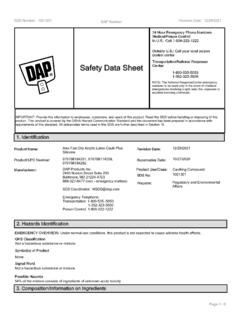Transcription of Polyvinyl Chloride Safety Data Sheet - Hummel Croton
1 Hummel Croton Inc. 10 Harmich Rd. South Plainfield, NJ 07080 Phone: 908-754-1800 Fax: 908-754-1815 In Case Of Emergency Call ( ) 800-424-9300 (International) +1-813-248-3924 Polyvinyl Chloride Safety data Sheet 1. Product and Company Product name: Polyvinyl Chloride Synonym: PVC, Vinyl CAS-No.: 9002-86-2 Company: Hummel Croton Inc. 10 Harmich Rd. South Plainfield, NJ 07080 Telephone: 908-754-1800 Fax: 908-754-1815 Emergency telephone number Emergency Phone #: Chemtrec US: 800-424-9300 ChemTel International: +1-813-248-0585 HMIS Rating Health 0 Flammabilitiy 1 Reactivity 0 Personal Protection E 2.
2 Hazards GHS Classification Skin irritation (Category 2), H315 Eye irritation (Category 2A), H319 Specific target organ toxicity - single exposure (Category 3), Respiratory system, H335 GHS Label elements Pictogram(s) Signal word WARNING Hazard statement(s) H315 Causes skin irritation. H319 Causes serious eye irritation. H335 May cause respiratory irritation. Precautionary statement(s) P261 Avoid breathing dust/ fume/ gas/ mist/ vapours/ spray. P264 Wash skin thoroughly after handling. P271 Use only outdoors or in a well-ventilated area. P280 Wear eye protection/ face protection.
3 P280 Wear protective gloves. P302 + P352 IF ON SKIN: Wash with plenty of soap and water. P304 + P340 + P312 IF INHALED: Remove victim to fresh air and keep at rest in a position comfortable for breathing. Call a POISON CENTER or doctor/ physician if you feel unwell. P305 + P351 + P338 IF IN EYES: Rinse cautiously with water for several minutes. Remove contact lenses, if present and easy to do. Continue rinsing. P332 + P313 If skin irritation occurs: Get medical advice/ attention. P337 + P313 If eye irritation persists: Get medical advice/ attention. P362 Take off contaminated clothing and wash before reuse.
4 P403 + P233 Store in a well-ventilated place. Keep container tightly closed. P501 Dispose of contents/ container to an approved waste disposal plant. Hazards not otherwise classified (HNOC) or not covered by GHS None. 3. Composition/Ingredients Substance Formula: (CH2 CHCl)n Molecular weight: Varies CAS-No.: 9002-86-2 Material CAS % OSHA ACGIH Polyvinyl Chloride 9002-86-2 99+% 15 mg/m3 as Nuisance Dust 15 mg/m3 as Nuisance Dust Bis(2-ethylhexyl) Phthalate* 117-81-7 < 1% 5 mg/m3 5 mg/m3 Vinyl Chloride Monomer** 75-01-4 < ppm 1 ppm 5 ppm * Bis(2-ethylhexyl) phthalate is an NTP anticipated human carcinogen and IARC possible human carcinogen.
5 ** Vinyl Chloride monomer is an OSHA cancer suspect agent, ACGIH confirmed human carcinogen and NTP and IARC human carcinogen. 4. First Aid First Aid For Eye: In case of contact, immediately flush eyes with plenty of water for at least 15 minutes. Call a physician. First Aid For Skin: In case of contact, flush skin with water. Wash clothing before reuse. Call a physician if irritation occurs. First Aid For Inhalation: If inhaled, remove to fresh air. If not breathing, give artificial respiration. If breathing is difficult, give oxygen. Call a physician. First Aid For Ingestion: If swallowed, call a physician immediately.
6 5. Fire data Flammability: Non-Flammable Flash Point: 391oC by ASTM D1929 Auto Ignition: Not Applicable Flammable Limits: Not Applicable Extinguishing Media: Water spray. Fire Fighting Procedure: Wear self-contained breathing apparatus and protective clothing to prevent contact with skin and eyes. Do not direct a solid stream of water or foam into burning molten material; this may cause spattering and spread the fire Fire/Explosion Hazards: Emits toxic fumes under fire conditions. 6. Accidental Release Spill Or Leak Procedures: Utilize recommended protective clothing and equipment.
7 Clean spills in a manner that does not disperse dust into the air. Spill area can be washed with water. Collect wash water for approved disposal. Keep from entering water or ground water. 7. Handling And Storage Storage Temperatures: Store at ambient temperature Shelf Life: Unlimited in tightly sealed container Special Sensitivity: None. Handling/Storage Precautions: Avoid breathing dust. Avoid getting in eyes or on skin. Wash thoroughly after handling. Store in a dry place away from direct sunlight, heat and incompatible materials. Reseal containers immediately after use.
8 Store away from food and beverages. 8. Exposure Controls/Personal Protection Eye Protection: Safety glasses or goggles. Skin Protection: PVC gloves with impervious boots, apron or coveralls. Wash hands and face before eating, drinking or using tobacco. Respirator: Work ambient concentrations should be monitored and if the recommended exposure limit is exceeded, a NIOSH/MSHA approved dust respirator must be worn. Ventilation: Use local ventilation if dusting is a problem, to maintain air levels below the recommended exposure limit. Additional Measures: Emergency showers and eye wash stations should be available.
9 Educate and train employees in the safe handling of hazardous chemicals. 9. Physical And Chemical Properties Physical Form: Free flowing powder Color: White Odor: Odorless Molecular Weight: Varies Boiling Point: Not Established Melting/Freezing Point: Decomposes above 250oC Solubility In Water: Insoluble Specific Gravity: 10. Stability And Reactivity Stability: Stable. Hazardous Polymerization: Will not occur. Incompatibilities: Avoid contact with strong oxidizers. Also, avoid contact with acetal or acetal copolymers and with amine containing materials during processing. At processing conditions, these materials are mutually destructive and involve rapid degradation.
10 Instable Conditions: Excessive temperatures (see incompatibilities). Decomposition Temperature: Prolonged heating of product above 200oC or short term heating above 250oC may result in rapid evolution of hydrogen Chloride . Decomposition Products: Hydrogen Chloride , carbon monoxide, carbon dioxide and small amounts of benzene and aromatic aliphatic hydrocarbons. 11. Toxicological Information RTECS Number: Not Established for Polyvinyl Chloride Routes of Exposure: Eye contact. Ingestion. Inhalation. Skin contact. Toxicity data : See Section III above and information below Chronic Toxic Effects: Vinyl resin has little effect on the lungs and is not known to cause any disease when dust exposure is minimized.


